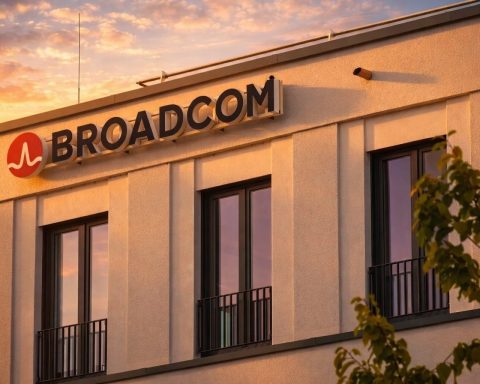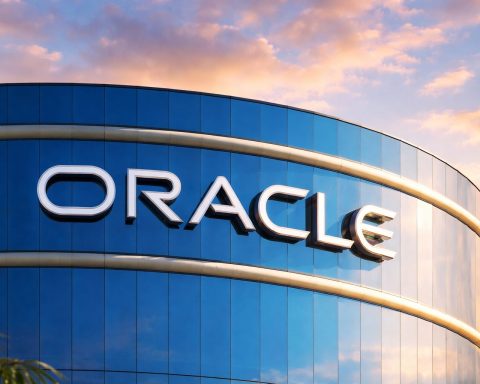- The Dow Jones Industrial Average hit an all-time intraday high, surpassing its December peak of 45,073 to join Nasdaq and the S&P 500 in 2025 highs.
- Warren Buffett’s Berkshire Hathaway disclosed a stake in UnitedHealth Group, sending UnitedHealth shares up about 9.5%.
- Nvidia’s market capitalization climbed to $4 trillion amid AI-driven rally.
- The Nasdaq Composite posted its 18th record close of 2025 and was up about 11% year-to-date.
- Apple said it will invest an additional $100 billion in U.S. projects, bringing its total commitment to $600 billion.
- Futures priced roughly an 89% chance of a September rate cut, despite warnings there is no data-based support yet.
- Meta Platforms announced its fourth AI-team reorganization in six months, creating the four-group “Superintelligence Labs.”
- Meta tapped PIMCO and Blue Owl to lead a $29 billion financing for data centers in Louisiana as it scales AI capacity, with 2025 CapEx guidance at $66–72 billion.
- Boxabl announced a $3.5 billion SPAC merger with FG Merger II to go public, aiming to scale foldable Casita homes.
- Advent International agreed to acquire Sapiens International for $2.5 billion in cash at $43.50 per share, a 47% premium.
Finance and Stock Markets
Global markets surged to new milestones by mid-August. On Friday, the Dow Jones Industrial Average hit an all-time intraday high, becoming the last of the big three U.S. indexes to join 2025’s record-setting rally [1]. It briefly surpassed its previous peak (45,073 from December) as blue-chip stocks caught up with earlier highs in the S&P 500 and Nasdaq [2]. “We have certainly waited a long time this year for the Dow… to join the new high club with the Nasdaq and S&P,” noted Art Hogan of B. Riley Wealth [3]. A 9.5% spike in UnitedHealth – after Warren Buffett’s Berkshire revealed a stake – helped propel the Dow’s climb [4]. Tech giants also buoyed indexes; Microsoft, Goldman Sachs, Caterpillar, and an AI-fueled Nvidia (now a $4 trillion market-cap company) led year-to-date gains [5].
The Nasdaq Composite likewise notched fresh records amid tech-sector optimism and growing bets on U.S. Federal Reserve rate cuts [6]. It marked the Nasdaq’s 18th record close of the year, now up ~11% in 2025 [7] [8]. Investors cheered news that Apple will invest an additional $100 billion in U.S. projects (bringing its commitment to $600 billion) [9]. The broader S&P 500 hovered just shy of its June peak but posted solid weekly gains [10]. Analysts say stocks have been “powered by tech stocks” and hopes of Fed easing [11] – a stark turnaround from the sharp selloff earlier in the year. Fed policy remains pivotal: futures put odds of a September rate cut at ~89% [12]. “There is no data-based support here for a rate cut in September,” cautioned economist Conrad DeQuadros after robust retail figures and sticky inflation expectations [13] [14]. Still, traders are eyeing the Fed’s upcoming Jackson Hole summit and inflation reports for direction [15] [16].
Overseas, European markets saw more modest moves. London’s FTSE 100 and the pan-European STOXX 600 ground higher in August [17], even as specific sectors fluctuated (see Technology, below). Meanwhile, emerging markets attracted attention – global investors poured money into non-U.S. equities in search of better growth and value [18]. In Asia, sentiment was mixed amid China’s ongoing property turmoil (see Real Estate) and cautious optimism about U.S.–China trade. Notably, the Indian market digested news that U.S.–India trade talks scheduled for late August were abruptly called off after Washington raised tariffs on Indian goods to 50% [19]. Despite geopolitical undercurrents, one strategist quipped, “Markets are at new highs despite [geopolitical conflicts]… Markets care more about consumers, inflation and [Fed] commentary from Wyoming next week.” [20] [21].
Technology and Innovation
Artificial Intelligence breakthroughs are reverberating across global markets and boardrooms. In Europe, a selloff in “AI adopter” stocks deepened as ever-more powerful AI models debut. Shares of enterprise software giants like SAP and Dassault Systèmes tumbled this week on fears that cutting-edge AI could upend traditional software and data analytics businesses [22]. OpenAI’s release of GPT-5, its latest large language model, in early August has raised the bar yet again [23]. “With every iteration of GPT or Claude that comes out…it’s multiples more capable than the previous generation. The market’s thinking: ‘oh, wait, that challenges this business model,’” observed Kunal Kothari of Aviva Investors, noting how new AI tools are forcing a rethink on companies from financial data providers to consulting firms [24]. Since mid-July, shares of European tech adopters like LSEG (London Stock Exchange Group), Sage Group, and Capgemini have each dived 10–15% [25]. Part of the pain is self-inflicted: many traded at lofty price-to-earnings multiples (SAP near 45× earnings) and were vulnerable to any shift in sentiment [26]. Analysts expect markets to eventually distinguish AI winners from losers, rather than blanket-punishing the sector [27]. For now, the rout underscores concerns that “AI may eat software.” Notably, U.S. indices haven’t flinched – major American tech stocks (propelled by AI hype and huge investment plans) continue to drive Wall Street’s rally [28].
Within Big Tech, the race for AI dominance is prompting bold moves. Meta Platforms is undergoing its fourth reorganization of AI teams in six months [29]. CEO Mark Zuckerberg has gone “all-in” on pursuing artificial general intelligence, fast-tracking projects to outthink humans and unlock new revenue [30]. According to insiders, Meta will split its new “Superintelligence Labs” unit into four groups, including a products team (e.g. the Meta AI assistant), a fundamental research lab (FAIR), and even a nebulously-defined “TBD” lab [31]. This shake-up follows high-profile staff departures and a “poor reception” to Meta’s latest Llama 4 AI model [32]. Meta is also pouring capital into infrastructure: it just tapped asset managers PIMCO and Blue Owl to lead a $29 billion financing for massive new data centers in Louisiana [33]. Zuckerberg says Meta will spend “hundreds of billions of dollars” building out AI supercomputing capacity [34]. While costly (Meta hiked its 2025 CapEx budget to $66–72 billion) [35], the investments aim to keep Meta in the AI arms race with Google, Microsoft, and OpenAI. Industry observers note that Silicon Valley’s AI contest has only intensified – even Apple drew attention this week by committing an extra $100 billion to U.S. projects, likely including AI and chip development [36].
In other tech news, automakers and mobility saw notable developments. Tesla’s long-awaited Cybertruck made headlines as a police fleet in Mexico deployed the futuristic EV pickup [37], highlighting how government fleets are embracing innovative tech ahead of the 2026 World Cup. And in the semiconductor space, Micron Technology raised its quarterly outlook on booming demand for AI memory chips [38] – further evidence that the AI boom is lifting some boats even as it rocks others. All told, tech and innovation remain the engine of global business news – driving stock gains, spurring M&A (see Deals), and forcing incumbents to adapt at breakneck pace.
Energy and Commodities
Oil markets are bracing for a bearish jolt after a high-stakes U.S.–Russia summit. U.S. President Donald Trump met Russia’s Vladimir Putin in Alaska on Friday to discuss the Ukraine war, and the outcome could keep oil supplies flowing freely. Trump agreed to hold off on sanctions and tariffs targeting Russian oil exports – a move conditioned on pursuing a peace deal for Ukraine [39] [40]. He had previously threatened to penalize China and India for buying Russian crude, but for now that threat is “put on hold” [41]. This détente eased immediate supply fears: “Russian oil will continue to flow undisturbed and this should be bearish for oil prices,” explained ICIS analyst Ajay Parmar [42]. Analysts expect only a modest reaction when markets reopen; prices might dip slightly in the near term [43]. Brent crude closed Friday at $65.85 a barrel and WTI at $62.80, both down nearly $1 before the talks [44]. “Traders are waiting for a concrete deal. Until that emerges, crude will likely stick in a narrow range,” said Phil Flynn of Price Futures, noting the lack of any immediate resolution [45]. Attention now turns to Monday’s scheduled meeting between Trump and Ukraine’s President Zelenskiy in Washington, which European leaders will also attend [46] [47]. “Market participants will track comments from European leaders, but for now Russian supply disruption risks remain contained,” observed Giovanni Staunovo, commodity analyst at UBS [48]. In short, the prospect of peace – however tentative – has removed some geopolitical risk premia from oil.
Beyond geopolitics, the energy sector saw significant corporate moves. In Brazil, state-run oil giant Petrobras is mulling a return to biofuels. Local reports say Petrobras may invest in sugar-ethanol producer Raízen as a way to re-enter the ethanol market [49]. Petrobras had exited biofuel production in its 2017–2021 plan, but under new leadership it signaled interest in green energy again [50]. Raízen – the world’s largest sugar maker and a leading ethanol supplier (jointly owned by Shell and Cosan) – has openly sought a new partner amid financial hurdles [51]. Options on the table include Petrobras taking an equity stake or purchasing Raízen assets, with a decision possible by year-end [52] [53]. This comes as many oil majors worldwide invest in renewables to diversify their portfolios. Meanwhile, U.S. policy took a turn that could impact energy investment: the Trump administration unveiled stricter rules on wind and solar subsidies, aiming to curb what it sees as overly generous green incentives [54]. Renewables developers argue this could slow progress on clean energy projects, even as climate-driven demand grows.
In metals and commodities, price action was mixed. Gold prices have been relatively steady around recent highs, but some strategists see weakness ahead if geopolitical risks abate. “Gold and precious metals are likely to sell off… Given inflation concerns, any dip could be a buying opportunity,” advised Eric Teal of Comerica, reflecting a common view that bullion’s appeal might cool if war fears ebb [55]. Industrial commodities like copper and iron ore are watching China’s economy closely – any further stimulus (or lack thereof) could sway demand. Thus far, Beijing’s modest easing measures haven’t reversed the slowdown in construction and manufacturing, keeping base metal prices under pressure. Agricultural markets, on the other hand, have been volatile with extreme weather: from North American droughts to a flash flood in northern China that killed 8 and disrupted farms [56], crop outlooks remain uncertain. Overall, energy and commodity markets are balancing short-term oversupply sentiments (thanks to diplomatic overtures) against longer-term structural shifts (toward renewables and climate impacts).
Real Estate and Housing
Global real estate continues to face headwinds, with China’s property crisis and high interest rates in the West shaping the narrative. In China, the unwinding of once-mighty developer Evergrande Group reached a symbolic moment – the company’s Hong Kong-listed shares will be delisted on Aug. 25 after 18 months of suspension [57]. Evergrande’s court-appointed liquidators reported they’ve managed to sell only $255 million in assets so far [58], against a staggering $45 billion in creditor claims [59]. In other words, just 0.5 cents on the dollar of assets have been realized, underscoring the scale of the $300+ billion collapse. The liquidation process – China’s largest ever – is bogged down by complex onshore asset seizures and inter-company guarantees [60] [61]. It could drag on for “more than a decade,” experts say [62]. Evergrande’s fall in 2021 was the first domino in China’s realty crunch; since then, dozens of developers (Sunac, Country Garden, etc.) have defaulted, as China’s property market remains in a multi-year tailspin [63]. Despite repeated government easing measures, homebuyer demand is weak and prices are under pressure in many cities. Policymakers in Beijing face a dilemma: how to stimulate housing (a key growth driver) without reflating a debt bubble. Investors worldwide are watching closely, as China’s real estate woes pose a risk to its economy and global commodity demand.
In contrast, U.S. housing is a story of high prices and high rates creating gridlock. The National Association of Realtors reports the median existing-home sale price in the U.S. hit a record $429,400 in Q2 2025 [64] – an all-time high, though annual price growth slowed to about 1.7%. In many metro areas, prices are beginning to decelerate, and a few previously red-hot markets (California, Florida, Texas) even saw modest year-over-year declines this summer [65]. Supply is finally creeping up (homes are sitting on the market longer, and 27% of listings had price cuts in July) [66], giving frustrated buyers a bit more leverage. However, affordability remains a major challenge. Mortgage rates hovering around ~6.5–7% have kept many buyers on the sidelines, offsetting the benefit of any small price declines [67] [68]. New home builders, flush with inventory, have resorted to incentives and price discounts – the median new home price in June fell ~3% from a year prior, to $402k [69]. “The housing market remains a challenge as high prices and elevated rates continue to keep borrowers on the sidelines,” NAR’s chief economist said, noting sales volumes are still subdued [70] [71]. There are regional bright spots: parts of the Midwest and Northeast, where markets are tighter and prices still rising at a healthy clip [72]. But nationally, analysts forecast essentially flat or slightly lower home prices by year-end [73] – a welcome cooling after the pandemic-era boom.
Elsewhere, commercial real estate trends diverge. In the U.S. and Europe, high interest rates have repriced office and retail property values downward, and deal activity is sluggish. Yet sectors like industrial/logistics space remain resilient thanks to e-commerce demand. The Middle East stands out as a hotspot: Gulf cities report strong real estate investment (Dubai’s property transactions, for instance, are on pace for record volumes in 2025, fueled by foreign buyers and economic diversification). And in a bid to address housing affordability, innovative solutions are drawing investor interest – e.g., Boxabl, a Las Vegas modular home startup known for $20,000 foldable “Casita” units, just announced plans to go public via a $3.5 billion SPAC merger to scale up production [74] [75]. The appeal of rapid, prefab housing construction is growing “as rising housing prices hit record highs amid supply crunch”, Boxabl noted [76]. Real estate may be cyclical, but the search for innovative housing solutions and the fallout from past excesses are both very much in focus as we head into late 2025.
Retail and Consumer Trends
Consumer spending showed remarkable resilience, although clouds are forming on the horizon. In the U.S., retail sales jumped a solid +0.5% in July, beating expectations [77] [78]. American shoppers snapped up autos (sales at auto dealers +1.6%) and flocked to summer promotions by retail giants Amazon and Walmart [79] [80]. Both companies staged extended discount events (Amazon’s Prime Day deals spanned 96 hours this year) to entice inflation-weary consumers [81]. The strategy worked: e-commerce sales rose 0.8% on the month [82] and categories like clothing and furniture saw notable gains [83] [84]. The Commerce Department also revised June’s retail sales upward, suggesting the economy entered Q3 with more momentum than thought [85] [86]. This strength eased fears of an imminent slowdown and led some to boost GDP forecasts. However, the very robustness of spending is complicating the fight against inflation. Many businesses have successfully passed higher costs (including new import tariffs) on to consumers [87], and the University of Michigan survey showed consumer inflation expectations ticked up in August [88]. That has tempered hopes for aggressive Fed rate cuts.
Another concern is a “softening labor market.” Job growth over the past three months has been anemic by post-pandemic standards [89]. If hiring and wage growth cool further, households could retrench later in the year. “A softening job market and higher goods prices could curb consumer spending growth in the third quarter,” Reuters noted, pointing to these countercurrents [90]. Indeed, even as retail sales climbed, consumer sentiment edged down in August. The re-imposition of U.S. tariffs on a wide range of imports (part of Trump’s trade strategy) has likely dented confidence – “consumer sentiment worsened… snapping two months of improved attitudes, as Trump’s tariffs push prices higher,” according to one survey [91]. The American consumer, however, has proven resilient through multiple headwinds (inflation, rates, and now tariffs). As earnings season continues, big retailers like Walmart, Target, and Home Depot are reporting results that show mixed trends: non-essential categories are softer, but spending on travel, dining, and experiences remains robust. Carol Schleif of BMO Wealth noted that markets are less preoccupied with geopolitical drama because “consumers [and] inflation” at home are more crucial [92].
Globally, consumer trends are diverging. In Europe, retail sales volumes have been flat or falling – high energy costs and rising loan rates squeeze disposable incomes. Eurozone consumer confidence is still below long-term averages, though it has improved from last year’s lows. In China, consumer spending is growing but not as fast as expected; July saw weaker retail sales growth as youth unemployment and property worries weigh on sentiment [93]. Beijing is trying to spur consumption (e.g. tax breaks on EV purchases, subsidies for appliances), but the boost has been modest. On the brighter side, travel and tourism are booming in many regions. U.S. air travel hit record highs this summer, European tourist hotspots report a strong season, and China just lifted its ban on group tours to key markets, unleashing pent-up demand. Luxury retailers and hospitality firms are benefiting from this post-pandemic travel surge. Yet, a potential spoiler for consumers everywhere is energy prices – gasoline and utility costs. Thus far, oil’s pullback to the mid-$60s has kept gas prices in check, but any reversal could pinch wallets again. Policymakers will be watching consumer spending closely: it’s the backbone of the U.S. economy and a major swing factor for recession risks (or lack thereof) heading into 2026.
Mergers, Acquisitions, and IPOs
Deal-making is alive and well, spanning sectors from fintech to software to housing. In a notable private equity buyout, U.S.-based Advent International agreed to acquire Israel’s Sapiens International for $2.5 billion in cash [94]. Sapiens is a global provider of software to the insurance industry. The deal, at $43.50/share, represents a hefty 47% premium to Sapiens’ pre-announcement price [95], reflecting the hot demand for tech solutions in finance. Advent’s managing director Douglas Hallstrom emphasized the AI angle, saying “Insurers are increasingly turning to technology to boost growth and profitability… We will work with [Sapiens] to accelerate investment into AI and customer-centric solutions.” [96]. This continues a trend of PE firms targeting fintech and insurance software providers, betting they can capitalize on digitization in traditionally analog industries. (Notably, Advent has also been active in Europe’s insurance market, though it recently failed in a bid for UK’s Spectris [97].) Once the Sapiens deal closes, the company will be taken private, with one of its large shareholders retaining a minority stake [98].
Meanwhile, the IPO market is cautiously reopening with some high-profile listings. Crypto exchange Bullish (backed by CoinDesk’s parent) is reportedly moving ahead with an almost $1 billion IPO plan [99], aiming to debut amid a rebound in crypto markets this year. And as mentioned earlier, housing startup Boxabl announced it will go public via a merger with FG Merger II SPAC, valuing the company at $3.5 billion [100]. Boxabl makes foldable modular homes and sees massive demand for affordable housing solutions in both disaster relief and mainstream markets [101] [102]. The SPAC route allows Boxabl to raise capital and expand production without the lengthy traditional IPO vetting. “The institutional appetite for SPAC IPOs never really went away,” notes Richard Humphrey of SPAC Research, adding that regulators are now less hostile as the market normalizes [103]. Indeed, after a dry spell in 2022–2024, SPAC mergers are picking up again for niche high-growth firms. In Boxabl’s case, the transaction will inject funds to scale its factory output and invest in R&D, with the company touting the potential to ease housing shortages through quick-deploy homes [104] [105].
Other M&A highlights from around the world: China’s Ant Group (Alibaba’s fintech arm) reassured investors that its planned HK$2.8 billion acquisition of brokerage Bright Smart is on track [106] [107]. A media report had suggested regulators might delay approval, sending Bright Smart’s stock plunging 26%, but Ant insists all procedures are “moving forward as planned.” [108] [109] This relatively small deal is seen as a litmus test of Beijing’s regulatory stance post-Ant’s 2020 crackdown and $1 billion fine; Ant’s ability to complete acquisitions could signal it’s closer to reviving its shelved IPO ambitions [110] [111]. In Europe, London saw activist investor drama: shareholders of Third Point Investors Ltd approved a complex deal to buy a reinsurance firm (Malibu Life) from Dan Loeb’s fund [112] – part of a plan to narrow Third Point’s discount to NAV. And global merger volumes have quietly crept up: year-to-date announced M&A is ~$2.6 trillion globally [113], a peak boosted by megadeals like Union Pacific’s $85 billion bid for Norfolk Southern and OpenAI’s $40 billion fundraising (though those are still in progress). The deal pipeline for late 2025 looks solid as companies adjust strategies and cash-rich investors seek targets. Bankers say cross-border deals are back too, as evidenced by a surge in Middle East and Asian buyers looking at assets in Europe and North America.
Regulatory and Policy Changes
Policy shifts and legal decisions in the past 48 hours could have far-reaching impacts on businesses. In Washington, the Federal Reserve made a noteworthy regulatory tweak: it scrapped its “novel activities” supervision program – a special oversight initiative created in 2023 to monitor banks’ crypto and fintech exposures [114]. The Fed said the dedicated program is “no longer needed” now that it has integrated crypto/fintech risk monitoring into its standard oversight [115] [116]. In practice, this means banks dealing in digital assets won’t face a separate Fed taskforce; instead, they’ll be supervised through normal channels. The move suggests regulators feel they’ve gained a better handle on crypto risks (after a tumultuous 2022), but critics worry it could also signal a lighter touch exactly when crypto activity is rebounding. The Fed’s decision aligns with other U.S. agencies easing some post-2010 regulations, even as debates continue over how to police fintech innovations. Banking experts note this could encourage more banks to experiment with blockchain or partner with fintechs, now that oversight will be routine rather than via a heightened “novel” framework [117].
In a dramatic legal ruling, a U.S. appeals court cleared President Trump to resume mass firings at the Consumer Financial Protection Bureau (CFPB) [118]. The administration had aimed to oust up to 1,500 employees and effectively neuter the consumer watchdog agency, which Trump has openly criticized. A trial court halted those firings in April, saying the purge violated an injunction protecting the CFPB [119] [120]. But in a split 2-1 decision, the D.C. Circuit Court found the lower court lacked jurisdiction and “improperly blocked” Trump’s actions [121]. The ruling is stayed pending further appeal, so pink slips won’t go out immediately [122]. Nonetheless, it marks a potential turning point: the White House’s long-held goal to radically shrink the CFPB may now proceed. Florida Attorney General Pam Bondi hailed it as “another win for President Trump” and said it will free the agency to “right-size itself” [123]. Bondi even referred to “our effort to dismantle” the CFPB [124], although officially the administration says it will retain a scaled-back bureau for consumer education. Consumer advocates are alarmed – they argue this could leave the public unprotected from predatory financial practices [125] [126]. If the decision stands, expect major upheaval in the CFPB and possibly more deregulatory moves in finance (e.g. relaxed payday lending rules, reduced enforcement). Business groups, especially in banking and payday lending, have long chafed at CFPB oversight and would welcome a neutered bureau.
On the international front, trade policy is in flux. A new EU–U.S. trade accord that was announced in principle last month has stalled over digital regulation disputes [127]. The European Union is adamant that its landmark Digital Services Act (DSA) – which imposes strict rules on Big Tech to police content and protect users – not be undermined by any trade deal [128]. The U.S. side, at the urging of tech companies, has pushed to label some EU tech rules as “non-tariff barriers” and seek future concessions [129] [130]. According to an FT report Sunday, EU officials say this disagreement over language is a key reason a formal joint statement hasn’t been released yet [131]. The July mini-deal between Trump and European Commission President Ursula von der Leyen averted a broader tariff war – Trump imposed a 15% tariff on most EU imports instead of the threatened 30% [132], and Europe agreed to boost imports of American goods. As part of that truce, the U.S. was supposed to cut its hefty 27.5% tariff on European car imports down to 15% by Aug 15 [133]. EU officials anticipated Trump would sign that order this past week, but as of Sunday it appears held up by these digital rule frictions [134] [135]. The Digital Services Act is a red line for the EU – “relaxing these rules is a red line,” Brussels has said [136] – whereas Washington claims the DSA “stifles free speech and imposes costs on U.S. tech firms” [137]. This transatlantic tussle pits American tech giants’ interests against European regulators’ philosophy, and it’s now complicating broader trade cooperation. Businesses on both sides would benefit from tariff reductions and regulatory alignment, but digital policy remains a sticking point.
Finally, elsewhere in policy: India–Canada trade talks were unexpectedly paused amid diplomatic spats, the UK moved forward with a bill to loosen post-Brexit financial rules (the “Edinburgh Reforms”), and Japan unveiled plans to curb export of chip-making equipment under new security guidelines (mirroring U.S.-led tech sanctions on China). Each of these shifts reflects the complex interplay of economics and politics. For companies, staying abreast of regulatory changes – whether it’s compliance with new digital content laws, or adjusting supply chains to sidestep tariffs – is as critical as ever. As one market strategist put it, “tariffs and trade remain an uncertainty” even in an environment where investors are laser-focused on inflation and growth [138] [139]. The second half of 2025 promises more policy-driven crosswinds, requiring vigilance from global businesses.
Sources:
- Reuters Business & Markets News (Aug 15–17, 2025) [140] [141] [142] [143] [144]
- Reuters Technology News [145] [146]; Reuters AI/Tech Market Analysis [147] [148]
- Reuters Energy & Commodities News [149] [150] [151]
- Reuters World & Politics News [152] [153]; Reuters Legal News [154] [155]
- Reuters M&A/IPO News [156] [157] [158] [159]
- U.S. Housing Market Data – Empower/NAR Report [160] [161]; Reuters U.S. Retail Report [162] [163]
- Expert commentary via Reuters interviews: Art Hogan [164], Ajay Parmar [165], Giovanni Staunovo [166], Kunal Kothari [167], Douglas Hallstrom [168], Pam Bondi [169], and others as cited above.
References
1. www.reuters.com, 2. www.reuters.com, 3. www.reuters.com, 4. www.reuters.com, 5. www.reuters.com, 6. www.reuters.com, 7. www.reuters.com, 8. www.reuters.com, 9. www.reuters.com, 10. www.reuters.com, 11. www.reuters.com, 12. www.reuters.com, 13. www.reuters.com, 14. www.reuters.com, 15. www.reuters.com, 16. www.reuters.com, 17. www.reuters.com, 18. www.reuters.com, 19. www.reuters.com, 20. www.reuters.com, 21. www.reuters.com, 22. www.reuters.com, 23. www.reuters.com, 24. www.reuters.com, 25. www.reuters.com, 26. www.reuters.com, 27. www.reuters.com, 28. www.reuters.com, 29. www.reuters.com, 30. www.reuters.com, 31. www.reuters.com, 32. www.reuters.com, 33. www.reuters.com, 34. www.reuters.com, 35. www.reuters.com, 36. www.reuters.com, 37. www.reuters.com, 38. www.reuters.com, 39. www.reuters.com, 40. www.reuters.com, 41. www.reuters.com, 42. www.reuters.com, 43. www.reuters.com, 44. www.reuters.com, 45. www.reuters.com, 46. www.reuters.com, 47. www.reuters.com, 48. www.reuters.com, 49. www.reuters.com, 50. www.reuters.com, 51. www.reuters.com, 52. www.reuters.com, 53. www.reuters.com, 54. www.reuters.com, 55. www.reuters.com, 56. www.reuters.com, 57. www.reuters.com, 58. www.reuters.com, 59. www.reuters.com, 60. www.reuters.com, 61. www.reuters.com, 62. www.reuters.com, 63. www.reuters.com, 64. www.empower.com, 65. www.empower.com, 66. www.empower.com, 67. www.empower.com, 68. www.empower.com, 69. www.empower.com, 70. www.empower.com, 71. www.empower.com, 72. www.empower.com, 73. www.empower.com, 74. www.reuters.com, 75. www.reuters.com, 76. www.reuters.com, 77. www.reuters.com, 78. www.reuters.com, 79. www.reuters.com, 80. www.reuters.com, 81. www.reuters.com, 82. www.reuters.com, 83. www.reuters.com, 84. www.reuters.com, 85. www.reuters.com, 86. www.reuters.com, 87. www.reuters.com, 88. www.reuters.com, 89. www.reuters.com, 90. www.reuters.com, 91. abcnews.go.com, 92. www.reuters.com, 93. www.youtube.com, 94. www.reuters.com, 95. www.reuters.com, 96. www.reuters.com, 97. www.reuters.com, 98. www.reuters.com, 99. www.pymnts.com, 100. www.reuters.com, 101. www.reuters.com, 102. www.reuters.com, 103. www.reuters.com, 104. www.reuters.com, 105. www.reuters.com, 106. www.reuters.com, 107. www.reuters.com, 108. www.reuters.com, 109. www.reuters.com, 110. www.reuters.com, 111. www.reuters.com, 112. www.reuters.com, 113. www.reuters.com, 114. www.reuters.com, 115. www.reuters.com, 116. www.reuters.com, 117. www.reuters.com, 118. www.reuters.com, 119. www.reuters.com, 120. www.reuters.com, 121. www.reuters.com, 122. www.reuters.com, 123. www.reuters.com, 124. www.reuters.com, 125. www.reuters.com, 126. www.reuters.com, 127. www.reuters.com, 128. www.reuters.com, 129. www.reuters.com, 130. www.reuters.com, 131. www.reuters.com, 132. www.reuters.com, 133. www.reuters.com, 134. www.reuters.com, 135. www.reuters.com, 136. www.reuters.com, 137. www.reuters.com, 138. www.reuters.com, 139. www.reuters.com, 140. www.reuters.com, 141. www.reuters.com, 142. www.reuters.com, 143. www.reuters.com, 144. www.reuters.com, 145. www.reuters.com, 146. www.reuters.com, 147. www.reuters.com, 148. www.reuters.com, 149. www.reuters.com, 150. www.reuters.com, 151. www.reuters.com, 152. www.reuters.com, 153. www.reuters.com, 154. www.reuters.com, 155. www.reuters.com, 156. www.reuters.com, 157. www.reuters.com, 158. www.reuters.com, 159. www.reuters.com, 160. www.empower.com, 161. www.empower.com, 162. www.reuters.com, 163. www.reuters.com, 164. www.reuters.com, 165. www.reuters.com, 166. www.reuters.com, 167. www.reuters.com, 168. www.reuters.com, 169. www.reuters.com










